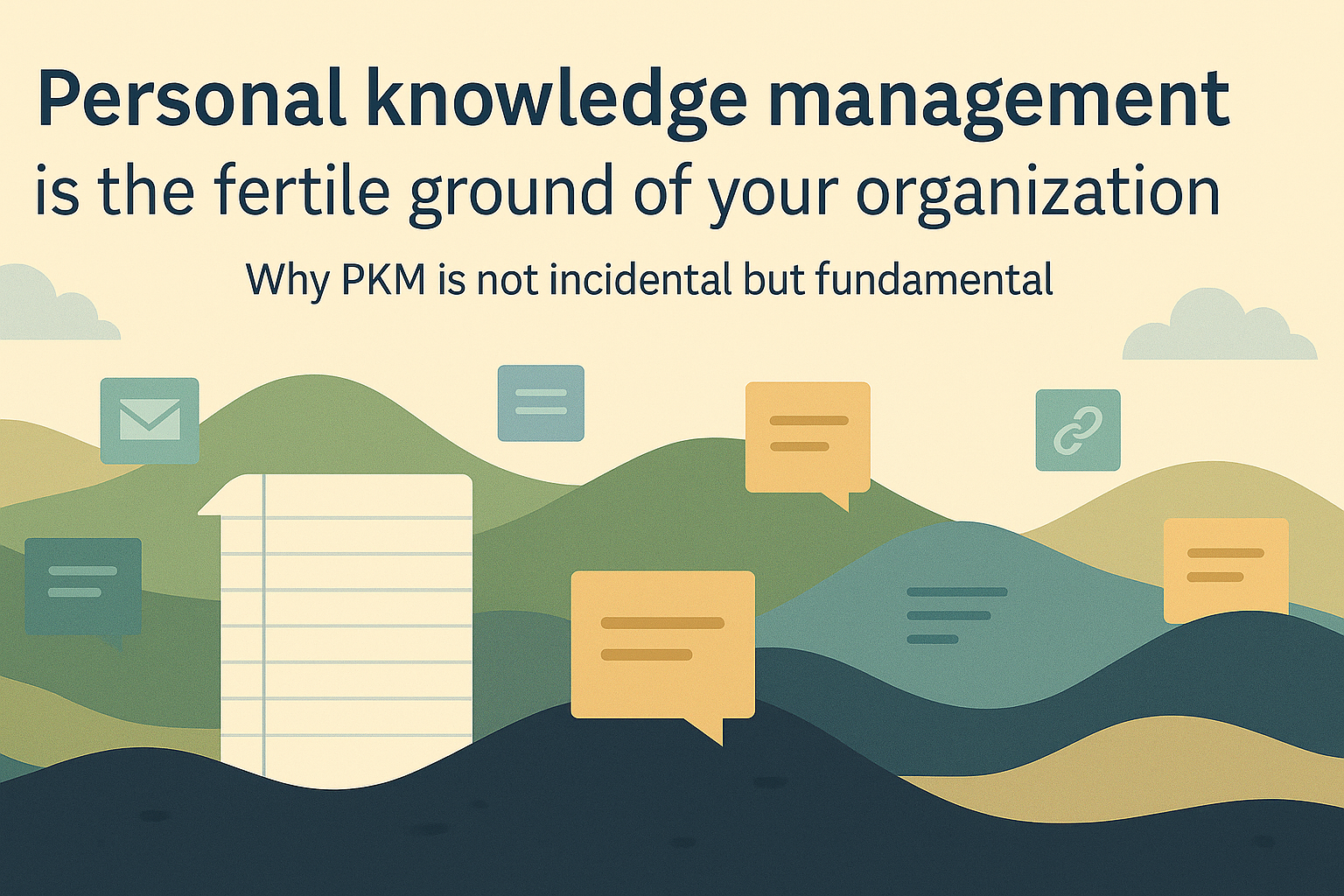Do you work at a large organization? Chances are there’s heavy investment in systems. In portals. In even more tools. Every year, a small fortune is spent on platforms intended to promote “knowledge sharing.” But almost no one asks the most fundamental question: do our people actually have control over their own information?
The term Personal Knowledge Management (PKM) might sound like something from the self-help aisle, but it’s actually a fundamental part of daily work. In fact: it is the daily work — only nobody calls it that.
In an employee’s life, an enormous flow of information enters every day. From the moment they wake up until they go to sleep. Things they read, hear, think, jot down, are told, remember — or forget. Insights on the bike. Sentences from a book. A link from a colleague. A note from three months ago. Sometimes private, sometimes professional — but always personal.
In an employee’s life, an enormous flow of information enters every day. From the moment they wake up until they go to sleep. Things they read, hear, think, jot down, are told, remember — or forget. Insights on the bike. Sentences from a book. A link from a colleague. A note from three months ago. Sometimes private, sometimes professional — but always personal.
What happens to all that information?
Not much. Because we’ve never taught people how to capture, organize, enrich, and retrieve that kind of knowledge. This is the blind spot of large organizations: they expect people to work with what they know, but they don’t give them the tools or the skills to manage that knowing.
And so insights get lost. Ideas disappear. Wheels are reinvented. People start tinkering with documents they know they’ve created before — but can’t find anymore. Unnecessary duplication of work, easily costing 500 hours a year per employee. Not because the employees are incompetent, but because no one has ever taken them seriously as knowledge workers. Nor have they been provided with the proper tools or methods to manage that work.
These days, it’s taken for granted that you’ll get a laptop, access to Teams, and a seat at the digital circus. But if someone wants to know how to quickly access their notes, how to connect fragments of thought to domain knowledge, or how to retrieve an idea at the moment it matters — silence.
PKM doesn’t appear in job descriptions. There’s (almost) no training for it. No manager ever asks about it.
There’s no KPI that tracks how well your information landscape is managed. And yet, it’s essential. Because information you can’t find is worthless. And knowledge that isn’t connected to your work changes nothing.
There’s no KPI that tracks how well your information landscape is managed. And yet, it’s essential. Because information you can’t find is worthless. And knowledge that isn’t connected to your work changes nothing.
The reality? We systematically underestimate information skills. Institutionally. Because it feels too personal. Too unscalable. Or because it’s confronting to realize how much potential remains untapped. But for those who do take it seriously, something remarkable happens:
Employees who can retrieve their knowledge think better. Decide better. Collaborate better.
They don’t need to reinvent the wheel. They can associate, build, combine, accelerate.
Instead of losing information to the chaos of the day, it becomes baggage they carry with them in everything they do. That is PKM. And it’s about time we finally started taking it seriously.
To be completely honest: nearly all large organizations we’ve worked with over the past five years are collectively blind to this side of information. Institutionally blind, even.
The information specialists within those organizations are often smart, dedicated professionals. They speak at length about systems, datasets, governance, lifecycle management. About how information needs to be standardized and secured.
But they almost never talk about what an individual employee actually absorbs on a daily basis — and what they could do with that. Because where does most information come from, really? Not from a system. Not from a report. Not from a policy document. But from a podcast someone listens to on their commute. An article on LinkedIn. A sudden insight in a traffic jam. A comment from a colleague at the coffee machine.
My cautious estimate: 90% of the information that enters an employee’s world in a day is not in formal systems. Not in SharePoint. Not in Topdesk. Not in what we call “the data.” And so the majority of real information needs are unseen. Unacknowledged. Let alone supported. In fact, it sometimes seems as if people are a little afraid of it. Because it can’t be managed top-down. Because it escapes control, structure, tooling. Because personal knowledge management can’t be standardized.
And that’s the beauty of it: Every brain is different. That’s where the power lies.
A PKM system grows from within. It evolves organically. It works differently for everyone. And that’s exactly why it’s so powerful. And exactly why it’s often ignored. If you want people to think, learn, associate, build, improve — start with their personal information work. That’s where the seeds are planted. Where context is created. Where connections are made. And opportunities emerge!
PKM is the fertile ground on which every good idea grows better.
To cultivate PKM, digital fitness is a crucial foundation. Digital skills alone are not enough. At www.digitalfitness.com you can learn all about it.
